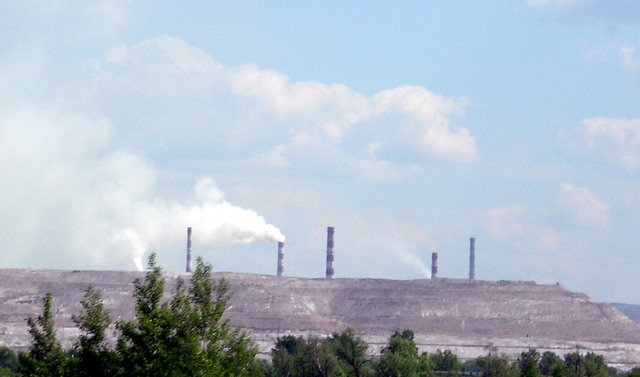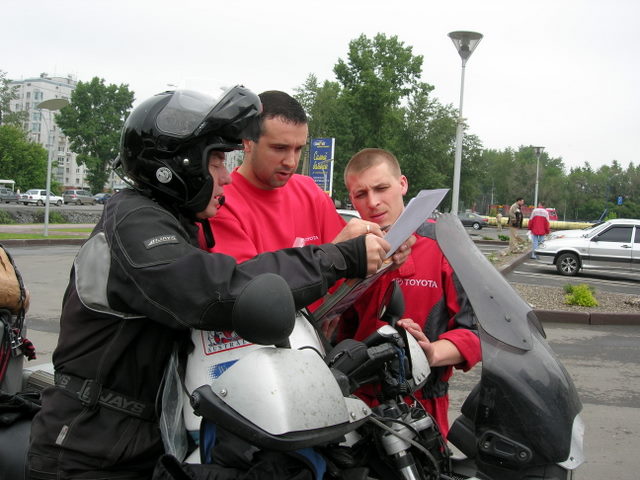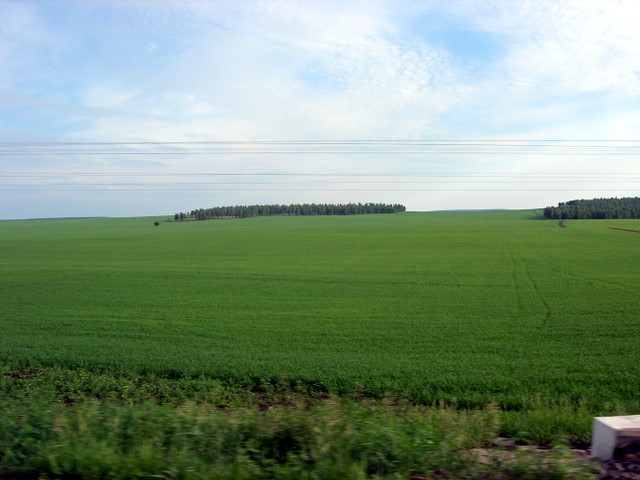Siberia!
5000 km east of Moscow, Mike and Jo draw breath to consider their transit of Siberia.12 to 22 Jun 08
Our return to, and final escape from, Moscow coincided with the first two days of a four day holiday weekend for Independence Day. We asked every Russian with whom we could communicate, from exactly what or whom was independence being celebrated, but no one seemed to know. I considered looking it up on the web, but thought, in the end, that if they don't know,why should I. The holiday actually fell on the Thursday, but the cunning Russians had all worked a previous Saturday as a normal workday so they could have a long weekend.
Whatever the reason for the holiday, the consequence was an extraordinary amount of traffic on the roads, much of it weekend drivers. As we went back into Moscow it was going the other way so we had a dream run. But on Friday the 12th we were in the thick of it all day. Not that a long weekend was needed to make life difficult on the road.
The Russians are world class when it comes to creating traffic chaos even on the freeways which are a mass of dodging and weaving vehicles that results in many accidents. In a single day we saw 14 accidents on the run from Moscow to Nizhniy Novgorod (450 km). This is more than the total for the 10 preceding months on the road!
Another three vehicle prang blocks the road
Each day was a similar story with a dozen or more accidents in our path. In the built-up areas, each accident created a little more congestion and slowed traffic further. This had a bad effect on the ageing fleet of Ladas and Russian trucks that expired at inappropriate places creating further chaos. All of this made for a stop-start drive of crazy sprints between mauling jams.
Traffic jam endurance test for visitors.
To be fair, some of this was caused by the number of extra vehicles on the road for a holiday weekend. But even 4000 km east of Moscow, where the highways are mainly used by long distance trucks, accidents are a daily sight. Statistically at least, this put the Russians way ahead in the worst drivers stakes.
We had set ourselves the target of riding 500 km a day for 10 days to get across to Irkutsk on Lake Baikal. We also allowed 5 rest days for sightseeing and to allow us to service the bike and wash off the road grime before crossing into Mongolia. With two of our rest days used up in a return to Moscow, we didn't have a lot of fat in the schedule.
Now, 500 km is not a big day back in Oz. Here it is hard work. In addition to the road conditions and drivers, Russians also have to put up with some of the most heavily policed highways in the world. Police check points are every few km pulling over vehicles for offences, real or imagined, or just to check documents. We have been generally lucky with the police, but it was our 10th day on the road in Russia before we rode a full 500 km without being stopped.
It doesn't take long to work out why the railway is the most important mover of freight and people.
On the second day out from Moscow we got mixed up in the vehicles competing in and supporting the Trans Orientale Rally. This is a Paris Dakar type event, although in this case the event goes from St Petersburg to Peking.

St Petersburg to Peking Trans Orientale Rally competitor.
There is a serious investment in running a team in this event.
We got a chance to chat with some competitors and support staff at a few lunch and overnight stops but lost a lot interest in ever getting involved when we converted some of the costs to Aussie dollars! After a day and a half of riding together, the circus turned south for Kazakhstan and we headed north east into Siberia.

John van Rakinzen was with the Dutch team We found out he was born in Ringwood, Victoria, but we didn't hold it against him.
The country itself has been quite different from what we expected. The first 1000 km to the Ural Mountains, the area often described as Western European Russia, is green rolling hills much like rural Victoria, but seemingly endless. The Urals, when we did get to them, were a disappointment. They are not much of a range, at their best rising only 2000 m at the high point. Where we crossed, they were no more than some low hills.
There is lots of green because there is lots of water.
The romantic moment I had imagined, sitting on the watershed, with the West behind and Siberia and the East in front, passed unnoticed between morning tea and lunch without changing out of top gear.
Beyond the Urals, the country drops down onto the Siberian Plain. The Plain is more than 4000 km across and is low and swampy. The Spring melt-water doesn't drain away in the summer, leaving the water-table close to the surface or exposed. It also makes road-making very difficult. Most of the main road is bunded above the surrounding plain for vast distances.
It is often hard to get off the road because of the amount of water.
The roads vary between four lanes and a good surface (very occasionally), to badly deteriorated single lane where first and second gear are the best we could do, and we did better than any of the cars making about 40 km in an hour. In general, the roads have continued to deteriorate as we have traveled east.
Roads are of variable quality.
The fuel itself has been relatively cheap ($1.10/litre), but many stations only sell 80 and 92 octane, and this is poor feed for Elephant. The local cars seem to run fine on 80 or even 76 octane but we have found that this causes Elephant to fart a lot and lose interest in proce(e)ding(s).
Local cars seem to run OK on 80 or 76 octane fuel but Elephant doesn't like it much.
Any area that is above the water is cultivated and any area with tree cover is wet and, therefore, not cultivated. The area of arable land is breathtaking. We have ridden 5000 km through rich black-soil country and only now, at the eastern edge of Siberia, have we found some higher ground and sandier soils. One consequence of this is that it is difficult to find somewhere to pull off the road for a piss, without stepping off the road and into a swamp, and our usual roadside lunches have been out of the question.
Now, where is a dry tree to hide behind?
Instead of roadside picnics, we joined the brotherhood of long distances truck drivers and started to frequent the truck stop cafés and hotels. These places generally have a fuel station (they couldn't be called service stations here as all they do is sell fuel), a café and and a hotel. We have lunch at the cafés of soup, salad, bread and tea for about $4 each. We stay overnight at the hotels from $25 for the room ($5 extra for a shower) with dinner and breakfast equally good value.
A typical truck stop with accommodation upstairs and cafe down.
The decor in the cafe left us in no doubt where we were!
Obviously, services of all kinds thin out as you go east. This led to one longer than expected day when I failed to take Jo's advice and stop a suitable pub claiming we needed to ride an additional half hour to make our schedule. Four hours and 250 km later we were running out of time and options when we finally found an old Soviet block-house hotel in a provincial town. We arrived in time to see the town's mid-summer fire-works display, but not in time to find anywhere to eat. We were at least 200km ahead of schedule.
We have passed through many very poor rural villages in the last ten days. Most have no indoor plumbing of any kind and for many, wood burning is still the source of winter heat. The countryside is desperately poor and life seems tough.
In the poor rural villages log construction is still used.
This is not to say that Siberia is a backwater or even backwards generally. There is a resources and development boom underway here and big fortunes are still being made. The cities that are at the heart of the boom are thriving with new middle-class suburbs sprouting like mushrooms and construction cranes filling the sky. We have been into supermarkets out here that were as big and well stocked as any in Australia or Western Europe. Expensive cars and fashionable clothes are everywhere.
A skyline full of construction cranes is testament to the boom underway here...
...as are the residential projects in the big cities.
The agricultural sector has been left behind and those cities and towns that were built under dodgy Soviet central economic plans are struggling. Those cities hooked into the new economy are booming.
There is coal to burn in Siberia, which is exactly what they do with it in some very dirty power stations.
Siberian locals (and Russians generally) have been amazing. A request for directions often results in a local driving to the destination in his car while we follow or, as in this case, four pages of maps printed off the business computer to make sure we didn't get lost getting out of town.
It is hard to sum up our feelings on Siberia. Our antipodean minds have an innate understanding of the tyranny of distance. But this place, like much of Russia, flows out over the edge of our imaginations.
...and did I tell you how big this place is? The wheat just disappears over the horizon and continues to do so as you drive hundreds of km.

















